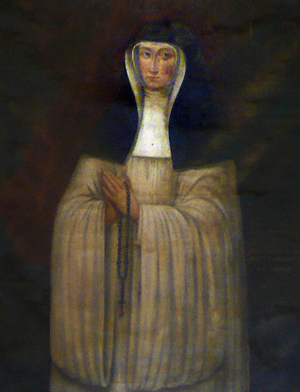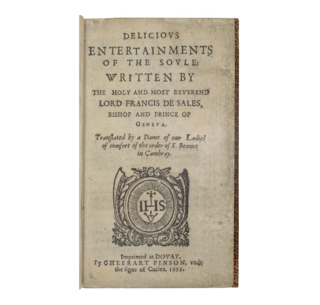
Dame Gertrude More (born as Helen More; 25 March 1606 - 17 August 1633) was a nun of the English Benedictine Congregation, a writer and chief founder of the abbey at Cambrai which became Stanbrook Abbey.

Dame Gertrude More (born as Helen More; 25 March 1606 - 17 August 1633) was a nun of the English Benedictine Congregation, a writer and chief founder of the abbey at Cambrai which became Stanbrook Abbey.
More was born in Low Leyton in Essex. Her father, Cresacre More, was great-grandson of Thomas More; [1] her mother, Elizabeth Gage, was sister of Sir John Gage, 1st Baronet of Firle, Sussex, Lord Chamberlain to Queen Mary. [2] Her mother died in 1611 and Helen's father, who had trained to be a monk, [3] became responsible for her care and education. Dom Benet Jones, a Benedictine monk, encouraged her to join his projected religious foundation, Our Lady of Comfort , in Cambrai. She was the first of nine postulants admitted to the order on 31 December 1623. Helen More came under the prescriptive influence of the Benedictine Augustine Baker and took the religious name of Gertrude. [1] She brought to the new organisation her lineage as the great-great-granddaughter of the Catholic martyr Thomas More, her education and a large dowry from her father that would fund the convent's creation. [4]
Catherine Gascoigne, one of her peers, was chosen ahead of her by the authorities in Rome as abbess in 1629 because she was older. [2] Gascoigne was more welcoming of Baker's advice. Sister More opposed Baker's approach but eventually gave into his ways - which included writing good books. [1]
Her writing was heavily influenced by the christian mystics such as Julian of Norwich and Teresa of Avila and other spiritual writers [5] and she contributed to the effort to publish their work. [6] [7]
The row at Cumbrai continued and Baker was recalled to Douai. Before the row was settled Gertrude died at Cambrai, from smallpox, aged 27. [1]
Some papers found after her death and arranged by Father Baker, were afterwards published in two separate works: one entitled The Holy Practices of a Divine Lover, or the Sainctly Ideot's Devotions (Paris, 1657); the other, Confessiones Amantis, or Spiritual Exercises, or Ideot's Devotions, to which was prefixed her Apology, for herself and for her spiritual guide (Paris, 1658).

Julian of Norwich, also known as Juliana of Norwich, the Lady Julian, Dame Julian or Mother Julian, was an English anchoress of the Middle Ages. Her writings, now known as Revelations of Divine Love, are the earliest surviving English language works by a woman, although it is possible that some anonymous works may have had female authors. They are also the only surviving English language works by an anchoress.

Elizabeth Barton, known as "The Nun of Kent", "The Holy Maid of London", "The Holy Maid of Kent" and later "The Mad Maid of Kent", was an English Catholic nun. She was executed as a result of her prophecies against the marriage of King Henry VIII of England to Anne Boleyn.

Gertrude the Great, OSB was a German Benedictine nun and mystic from the monastery of Helfta. She is recognized as a saint by the Catholic Church and figures in the General Roman Calendar on November 16 for optional celebration as a memorial throughout the Roman Rite.
Augustine Baker OSB, also sometimes known as "Austin Baker", was a well-known Benedictine mystic and an ascetic writer. He was one of the earliest members of the English Benedictine Congregation which was newly restored to England after the Reformation.

Stanbrook Abbey is a Catholic contemplative Benedictine Monastery with the status of an abbey, located at Wass, North Yorkshire, England.

Hengrave Hall is a Grade I listed Tudor manor house in Hengrave near Bury St. Edmunds in Suffolk, England and was the seat of the Kitson and Gage families 1525–1887. Both families were Roman Catholic recusants.
Saint Mary's Abbey in Colwich, Staffordshire was an abbey of Roman Catholic nuns of the English Benedictine Congregation, founded in 1623 at Cambrai, Flanders, in the Spanish Netherlands, and closed down in 2020. During the French Revolution, the community was expelled from France and settled at Mount Pleasant, Colwich, in 1836, where it remained for the next 84 years.

Sir Thomas Gascoigne, 2nd Baronet (1596–1686) was an English Baronet, a prominent member of the Gascoigne family and a survivor of the Popish Plot, or as it was locally known "the Barnbow Plot".
Richard Huddleston or Hudleston (1583–1655), was an English Benedictine monk.
Sir John Gage, 1st Baronet was an English baronet and landowner, and ancestor of the Viscounts Gage.
Anne Cary was a British Benedictine nun who founded 'Our Lady of Good Hope Convent' in Paris.
Mary Percy (1570–1642) was an English noblewoman who founded an English Benedictine Monastery in Brussels and served as its abbess.
Barbara Constable (1617–1684), professed as Dame Barbara Constable, was an English Benedictine nun, writer and transcriber. Her writing was a support to recusant Catholic communities and some of her transcriptions are the only known copies of Father Augustine Baker's works.
Mary Thimelby was an English prioress of St Monica at Leuven.

Margaret Clement was an English prioress of St Ursula's convent in Leuven.
Mary Lovel born Jane Roper and aka Mary Roper and Lady Lovel was the founder of the English Carmelite convent in Antwerp.

Catherine Gascoigne was the English abbess of Cambrai from 1624 to 1673.
Anne Neville born Mary Neville was an English Roman Catholic nun and royal debt collector who became the abbess of Pontoise near Paris.
Margaret Pygot was an English prioress of Carrow Abbey. She put the Abbey on a firm financial footing.

Pudentiana Deacon was a Benedictine nun now known for her translation of Les vrais entretiens spirituels by Francis de Sales (1557–1662).